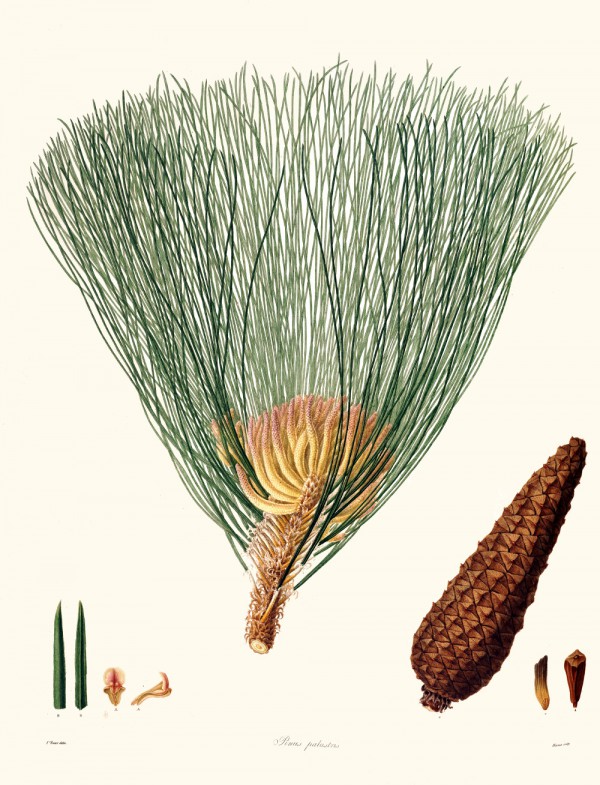Dies ist eine alte Version des Dokuments!
Pinus palustris Mill. - syn.Pinus australis F. Michx.; Pinus longifolia Salisb. - Pinaceae
longleaf pine, southern yellow pine, Sumpfkiefer
Evergreen tree, native to southeastern and southern North America; leaves (2)-3 per fascicle, 20-45cm long, persisting 2 years; pollen cones 30-80mm, purplish; seed cones ovoid-cylindric when open, 15-25cm, dull brown, maturing in 2 years. „Pinus palustris is fire successional, with a deep taproot and a definite grass stage. It is a valued species for lumber and pulpwood and was once important for naval stores (e.g., turpentine, pine oil, tar, pitch).“
http://www.efloras.org/florataxon.aspx?flora_id=1&taxon_id=200005348
„Turpentine is essentially a mixture of alpha-pinene and beta pinene. The approximate percentages are 65% α-pinene, 30% β-pinene, and 5% residue. Teh two pinenes are separated by fractional distillation under reduced pressure.“
[Stearns, Charles R., and J. Erskine Hawkins. „Catalytic hydrogenation of oleoresin from the slash pine (Pinus caribea).“ Proceedings of the Florida Academy of Sciences. Vol. 4. Temporary Publisher, 1939, 120]
„Commercial turpentine may be roughly divided into two general types, that produced from gum and that produced from wood. Gum turpentine is distilled from the oleoresin of the living tree. In the United States it is is obtained principally from two species, longleaf pine and slash pine (Pinus palustris Mill. and Pinus caribea Morel.).“
[Chadwick, Thomas Charles, and Samuel Palkin. Composition of American gum turpentine exclusive of the pinenes. No. 749. US Dept. of Agriculture, 1941, 1]
„Turpentine is a natural oleo-resin, formed as a physiological product in the trunks of Pinus palustris and other species of Pinus (see also Larch Turpentine)… The turpentine consists o an essential oil, known as turpentine oil, and a resinous substance known as Rosin. The latter is a mixture of various resin-acids and resin-acid anhydrides, commercially known as Abietic Acid. By steam distillation of turpentine, about one-sixth of the weight of the natural oleorsin distils with the water as turpentine oilwhile five-sixth are left as rosin…Derivatives of rosin are used as fixatives… Abietol (a mixture of dihydro- and tetrahydro abietic acid), Abalyn (methyl abietate), Hercolyn (methyl dihydroabietate), Hercolyn D (same, but distilled and deodorized).“
[Arctander, Steffen. Perfume and flavor materials of natural origin. 1960, 632; reprint Arctander, Steffen. Perfume and flavor materials of natural origin. Lulu. com, 2017, 377]
The essential oil of fresh needles and twigs, collected by steam distillation, consists mainly of β-pinene (32-50%). Other compounds present are germacrene-D (17.6%), (-)-camphene (14%), (-)-α-pinene (2-9%), α-terpineol (8%), δ-cadinene (5.1%), limonene (up to 5%), α-cadinol (4%), caryophyllene (3.8%) and other mono- and sesquiterpenes.
[Pini aetheoleum (Kiefernnadelöl aus Pinus palustris), Hagers Handbuch der Pharmazeutischen Praxis, Springer 2010]

Lambert, A.B., Description of the genus Pinus and some other remarkable plants, 2nd ed., vol. 1: t. 20 (1890) [Franz Bauer]
http://plantgenera.org/species.php?id_species=794927
